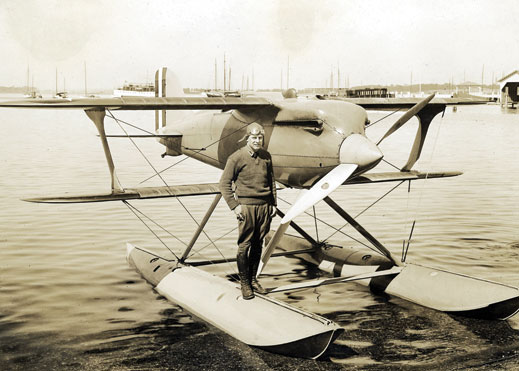Flying Blind
Jimmy Doolittle was not your typical prospective graduate student when he sought admission to MIT at 26, in the summer of 1923. The previous fall, the U.S. Army pilot had become the first to fly across the continental United States in less than 24 hours. He took off from the Florida coast on the night of September 4, made a brief refueling stop in Texas just after dawn, and touched down in San Diego in time for dinner on September 5.

It was then the experimental era of flight, and up to that point in his career Doolittle had mostly “flown by the seat of [his] pants,” as he recalled many years later. But for the historic cross-country sprint, he acquired a bank-and-turn indicator, the first time he would make use of such an instrument in the cockpit. He had also timed the trip for the full moon to “facilitate night flying,” but a band of heavy thunderstorms along the way foiled that plan. Blinding flashes of lightning, some “so close that their familiar ozone odor could be detected,” alternated with periods of complete darkness. Doolittle found that only the indicators were keeping him oriented in the turbulent night sky, impressing upon him the promise of such instrumentation for flying in conditions of little or no visibility.
Having been granted an undergraduate degree by the University of California, Berkeley, based on his engineering studies in the Army (he’d left school early to serve in World War I), Doolittle brought his wife and two young sons to live in an apartment in a Dorchester three-decker so he could attend MIT. Although he intended to study whether a suitably trained pilot could fly and land a plane without reference to the horizon or a point on the ground, his professors deemed this topic “not sufficiently abstract.” So Doolittle ended up focusing his thesis on the effect of wind on airplane performance through wind tunnel tests, surveys of his fellow pilots, and mathematical analyses.
Doolittle’s research at MIT shed light on many basic questions about flight that were then unresolved. Some pilots he interviewed said they could gauge wind velocity and direction by feel as they turned the plane or climbed in altitude, but his research proved that this was impossible. His research also looked at the effect of G forces on the human body and the likelihood that this was the cause of blackouts experienced by some pilots as they performed advanced maneuvers like loops, rolls, and spirals.
But Doolittle’s studies weren’t completely theoretical. He competed in races around the country and had regular access to the Air Service Reserve planes at Boston’s airport. During one joyride, Doolittle and a friend buzzed Lexington’s historic Main Street, then turned around and did it again as shop owners and townspeople looked on in amazement.
Doolittle’s thesis was accepted in 1925, but his research continued. With backing from the Guggenheim Fund, he returned to the question of whether more advanced technology could allow pilots to perform blind landings in dense fog or darkness. In 1929, using a plane specially outfitted with a radio beacon for communication with the ground and gyroscopes that established an “artificial horizon,” he took off and landed in a covered cockpit—the first “blind flight,” or one made completely with the aid of instruments.
When Doolittle resigned his Army commission to head the aviation department of the Shell Oil Company in February 1930, he had already done enough to secure his status as one of the major figures in the early history of aviation. But he continued to set air speed records in the early 1930s, and when World War II broke out he quickly returned to active duty. In 1942, he planned and led the first air raid on Japan by the U.S. Army Air Force. Sixteen bombers took off from a carrier in the Pacific, descended low over their targets in Japan to evade anti-aircraft fire, and then turned around, intending to land in Chiang Kai-shek’s China.
As it happened, bad weather obliterated all chances of a safe landing, and most of the pilots had to bail out. Although all 16 planes were lost and eight of the 80 crewmen were killed or captured, the audacious raid was a military and political success. Doolittle, who would live to the age of 96, was advanced two grades to general two days after the raid. He returned to the United States a war hero and was awarded the medal of honor for this seemingly impossible mission.
Keep Reading
Most Popular
Large language models can do jaw-dropping things. But nobody knows exactly why.
And that's a problem. Figuring it out is one of the biggest scientific puzzles of our time and a crucial step towards controlling more powerful future models.
The problem with plug-in hybrids? Their drivers.
Plug-in hybrids are often sold as a transition to EVs, but new data from Europe shows we’re still underestimating the emissions they produce.
Google DeepMind’s new generative model makes Super Mario–like games from scratch
Genie learns how to control games by watching hours and hours of video. It could help train next-gen robots too.
How scientists traced a mysterious covid case back to six toilets
When wastewater surveillance turns into a hunt for a single infected individual, the ethics get tricky.
Stay connected
Get the latest updates from
MIT Technology Review
Discover special offers, top stories, upcoming events, and more.